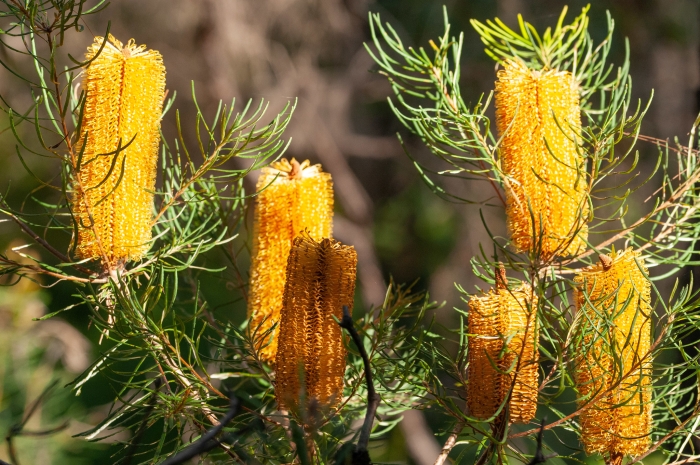Hairpin Banksia
(Banksia spinulosa)
Hairpin Banksia (Banksia spinulosa)
/
/

Rolf Lawrenz
CC BY 4.0
Image By:
Rolf Lawrenz
Recorded By:
Copyright:
CC BY 4.0
Copyright Notice:
Photo by: Rolf Lawrenz | License Type: CC BY 4.0 | License URL: http://creativecommons.org/licenses/by/4.0/ | Rights Holder: Rolf Lawrenz | Publisher: iNaturalist | Date Created: 2020-04-26T15:09-07:00 |























































Estimated Native Range
Summary
Banksia spinulosa, commonly known as Hairpin Banksia, is a versatile plant that can grow as a small, dense shrub or as a straggly tree. It is native to a variety of habitats including coastal heaths, open forests, and the edges of rainforests in Eastern Australia. Typically, it reaches up to 2 meters (7 ft) in height but can occasionally grow to 6 meters (20 ft). The Hairpin Banksia is characterized by its long, narrow leaves and distinctive inflorescences, which consist of cylindrical flower spikes with a golden or yellowish hue and styles that emerge in various colors such as black, purple, red, orange, or yellow. These flowers are particularly attractive to birds and pollinators, and they bloom from late summer to winter, adding interest to the garden during these seasons.
The Hairpin Banksia is valued for its unique flower spikes and the textural contrast its foliage provides in landscapes. It is often used in native plant gardens, as a feature shrub, and for habitat restoration projects. This species is adaptable to a range of soil types, though it has a preference for sandy, well-drained soils and thrives in acidic conditions. It is relatively easy to maintain, requiring only occasional pruning to maintain an attractive shape and prevent it from becoming leggy. While it is resistant to dieback, it is sensitive to iron deficiency, which can be mitigated with appropriate soil management. Banksia spinulosa is drought-tolerant once established and generally does best with low water requirements, in full sun to part shade. It can be propagated by seed or cuttings, with the latter being a more challenging but rewarding method for gardeners.CC BY-SA 4.0
The Hairpin Banksia is valued for its unique flower spikes and the textural contrast its foliage provides in landscapes. It is often used in native plant gardens, as a feature shrub, and for habitat restoration projects. This species is adaptable to a range of soil types, though it has a preference for sandy, well-drained soils and thrives in acidic conditions. It is relatively easy to maintain, requiring only occasional pruning to maintain an attractive shape and prevent it from becoming leggy. While it is resistant to dieback, it is sensitive to iron deficiency, which can be mitigated with appropriate soil management. Banksia spinulosa is drought-tolerant once established and generally does best with low water requirements, in full sun to part shade. It can be propagated by seed or cuttings, with the latter being a more challenging but rewarding method for gardeners.CC BY-SA 4.0
Plant Description
- Plant Type: Shrub
- Height: 3-10 feet
- Width: 1.5-3 feet
- Growth Rate: Moderate
- Flower Color: Brown, Orange, Yellow
- Flowering Season: Spring, Winter
- Leaf Retention: Evergreen
Growth Requirements
- Sun: Full Sun, Part Shade
- Water: Medium, High
- Drainage: Medium, Fast
Common Uses
Bank Stabilization, Bird Garden, Drought Tolerant, Groundcover, Hummingbird Garden, Low Maintenance, Rock Garden, Salt Tolerant, Showy Flowers, Street Planting
Natural Habitat
Native to coastal heaths, open forests, and rainforest edges in Eastern Australia
Other Names
Common Names: Hill Banksia, Golden Candlesticks, Hårnålsbanksia
Scientific Names: , Banksia spinulosa, Banksia spinulosa var. spinulosa, Banksia cunninghamii, Banksia denticulata, Banksia incognita, Sirmuellera spinulosa,
GBIF Accepted Name: Banksia spinulosa Sm.